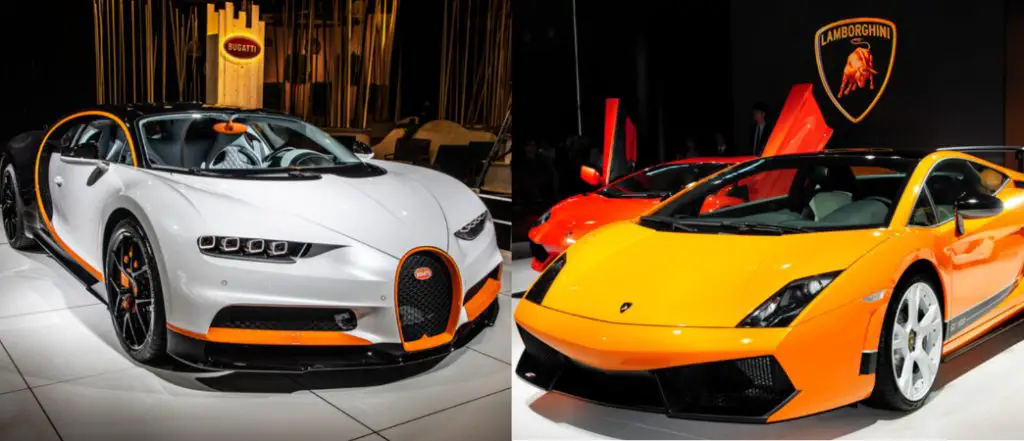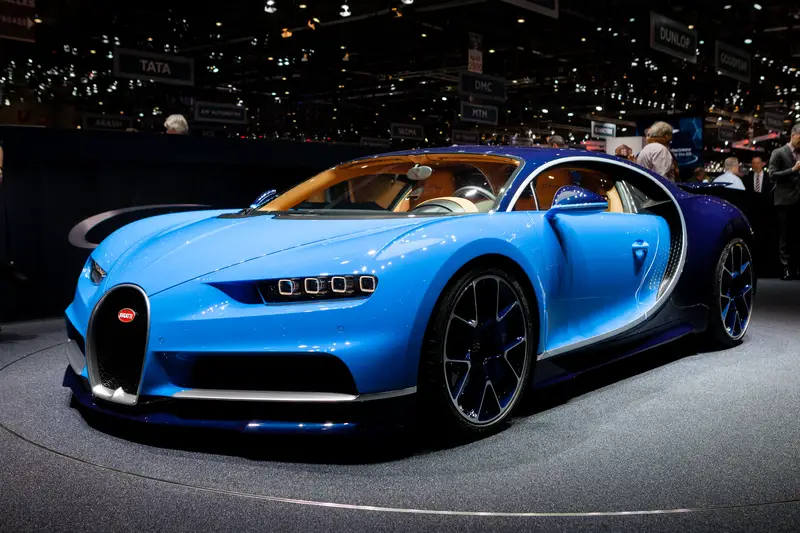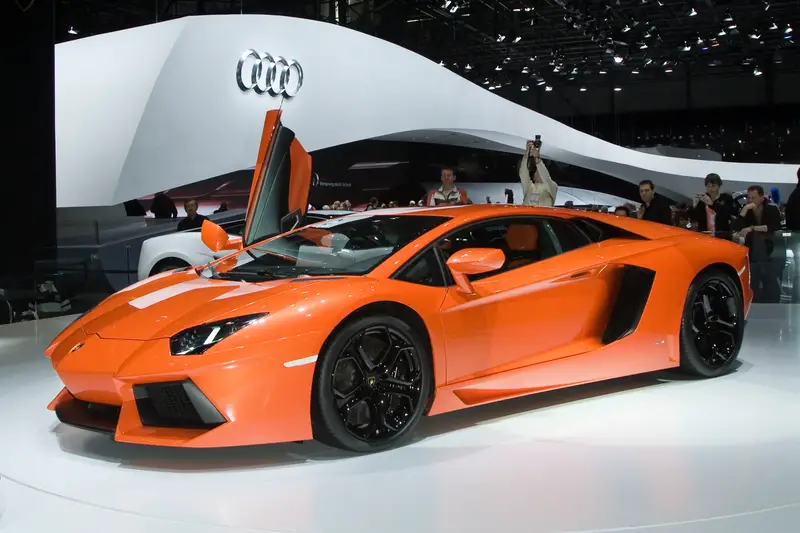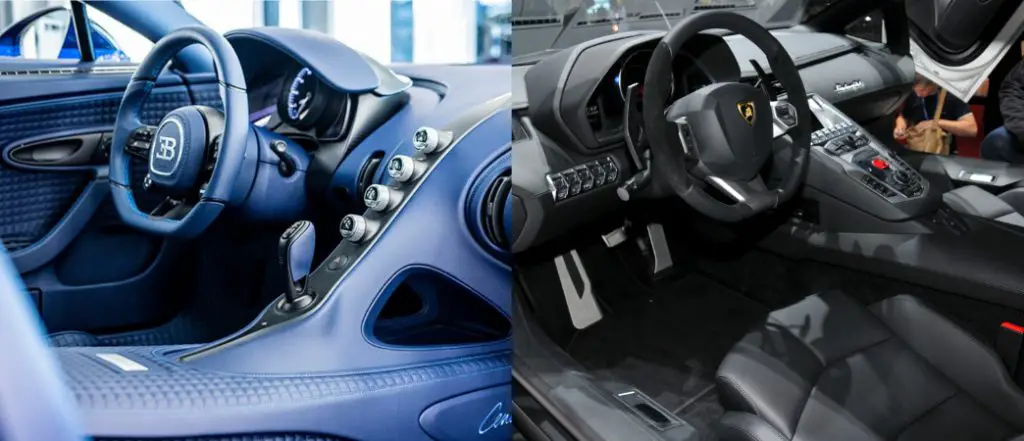
As two of history’s most renowned manufacturers of luxury vehicles, it is common for car fanatics to compare the models produced by Bugatti and Lamborghini over the years. So how do the two supercar brands of Bugatti and Lamborghini compare to each other?
While both Bugatti and Lamborghini produce supercars, the biggest difference between the car brands is exclusivity. There are only around 1000 Bugattis in the world, compared to Lamborghini’s 70,000. Bugatti’s are also faster, but way more expensive than Lamborghini.
Although Bugatti and Lamborghini have been supercar competitors for decades, it is virtually impossible to compare all their models throughout the years to say which car manufacturer is better.
Hence the flagship models of each manufacturer will be discussed, analyzed, and contrasted below in greater detail.
Comparing Their Flagship Models
While pure performance will suggest the Bugatti to be the superior vehicle, both cars’ exterior, interior, and technological features are comparable.
Therefore, it is a matter of preference and investor belief concerning which car you should purchase.
Bugatti

Touted as “The last of its kind” and “the ultimate roadster,” the flagship Bugatti model for 2022 was revealed to the world as the Bugatti W16 Mistral (slated for public release in early 2024). Consequently, there is no better manufacturer for high-speed open-top driving in the world!
Although Bugatti is clearly taking design and performance inspiration from their previous models like the Bugatti Veyron and Bugatti Chiron series, the Bugatti W16 is believed to be a wholly unique entry into the Bugatti line, with the production being limited to 99 units.
However, while a wholly unique entry into Bugatti’s vehicle line-up, the Bugatti W16 Mistral pays homage to much older manufacturer models similar to Ferrari Daytona SP3’s homage to the 330 P3/4, the 330 P4, and the 412 P.
Namely, the Bugatti W16 Mistral follows the bodywork and performance philosophy of their 1935 Chavigny Hill Climb winning model, the Type 57 Grand Raid Usine, thus affirming the company’s philosophy of art deco meets world-class engineering.
Lamborghini

Described as the ultimate merger between open-air driving, technological innovations, and decades of manufacturing pedigree, Lamborghini’s 2022 flagship is the Aventador 780-4 Ultimae Roadster.
Expanding and improving on the success and design philosophy of the Aventador 780-4, Lamborghini opted only to produce 250 units of the Aventador 780-4 Ultimae Roadster, making it the final and most exclusive model of the famed Avendator line!
Emissions & Fuel Consumption
As of the time of writing, Bugatti has yet to release official emission and fuel consumption statistics for the Bugatti W16 Mistral, as the model is not subject to 1999/94/EC. The reason is that type approval has not yet been granted as of the time of writing.
However, in the interim, the emission and fuel consumption statistics of the Bugatti Chiron Super Sport 300+ are a good indication of the approximate statistics for the Bugatti W16 Mistral (this is because the Bugatti W16 Mistral uses the 1,600 PS incarnation of the W16 engine seen in the Bugatti Chiron Super Sport 300+):
| CO2 Emissions | Fuel Consumption |
|---|---|
| Combined: 486.72 G/km | Low: 40.3 L/100 km |
| Mid: 22.15 L/100 km | |
| High: 17.89 L/100 km | |
| Extra high: 17.12 L/100 km | |
| Combined: 21.47 L/100km |
While potential buyers for the Aventador 780-4 Ultimae Roadster may not be as considered with the cost of petrol when measured against your average driver, the Aventador 780-4 Ultimae Roadster is not exceptionally light on fuel (which translates to higher than average CO2 emissions.)
According to the official website of the Aventador 780-4 Ultimae Roadster, fuel consumption and CO2 emissions are as follows:
| CO2 Emissions | Fuel Consumption |
|---|---|
| Combined: 398 g/km | Combined: 16 L/100km |
Powertrain & Performance
As mentioned above, the Bugatti W16 Mistral will feature a mid-engine quad-turbocharged 1,600 PS W16 coupled with a 7-speed dual-clutch automatic transmission.
Using the Bugatti Chiron Super Sport 300+ as a performance benchmark, the following performance markers are estimates for the Bugatti W16 Mistral (although evolutions in design and engineering may result in the Bugatti W16 Mistral’s surpassing their previous world-record speeds!)
- Maximum speed: 482 km/h
- 0 – 100 km/h: 2.4 seconds
- 0 – 200 km/h: 5.82 seconds
- Total displacement: 7993 cc
The Aventador 780-4 Ultimae Roadster is equipped with a 6.5 liter L539 V12, coupled with a 7-speed ISR Graziano automated manual transmission, and the Aventador 780-4 Ultimae Roadster showcases some impressive performance markers:
- Maximum speed: 355 km/h
- 0 – 100 km/h: 2.9 seconds
- 0 – 200 km/h: 8.9 seconds
- Total displacement: 6498 cc
However, despite these lightning-fast speeds, the Aventador 780-4 Ultimae Roadster falls shy of a few competitors in the supercar market (namely the Bugatti W16 Mistral.) However, the Aventador 780-4 Ultimae Roadster makes up for reduced speed with excellent handling via its 4-wheel drive steering.
The 4-wheel drive system combines an active steering system (Lamborghini Dynamic Steering) and a rear steering system (Lamborghini Rear-Wheel Steering.)
The merger of these two driving systems allows the Aventador 780-4 Ultimae Roadster to perform dynamic movements at low speeds via improved mobility while maintaining optimized control, stability, and comfort at higher speeds!
The 4-wheel drive system is further combined with a four active suspension which includes magnetorheological front and rear shock absorbers and a pushrod suspension system.
The four active suspensions further improve the Aventador 780-4 Ultimae Roadster’s performance, stability, and comfort across varying conditions.
Interior Design and Features

Bugatti’s mantra of “Form Follows Performance” couldn’t be more accurate when looking at the bodywork, interior design, and features of the Bugatti W16 Mistral.
While the Bugatti W16 Mistral may be a work of art, there are performance reasons for each design choice over simply looking elegant and stylish.
When discussing the headlights of the Bugatti W16 Mistral, deputy design director Frank Heyl explains that:
“Their [the headlights] are an aerodynamic aid that funnels air through the light and out through the wheel arch to improve aerodynamic drag. The horseshoe grille allows the high-temperature engine radiator to feed from one intake, leaving the two side intakes to focus only on providing air to the intercoolers.”
This philosophy and reasoning further extend to the taillights:
“[The taillights] serve the function of venting the side oil coolers through ducts connecting the negative triangular space between the X beams to the side radiators. Therefore, a pressure drop is created, which helps to manage the mid-temperature cooling circuit.”
The dashboard of the W16 Mistral, while being elegant and luxurious, was also crafted with readability in mind.
Therefore, large panels displaying easy-to-read and crucial information are presented to the driver, allowing for seamless communication between man and machine even while exceeding speeds of 400km/h!
Other notable interior flourishes include:
- Hand-woven leather seating and door covers, and
- An amber insert of Rembrandt Bugatti’s ‘dancing elephant’ in the gear shifter.
The Aventador 780-4 Ultimae Roadster is a unique combination between the ultra-modern design of the famed Aventador line and the classic finishes and design philosophy of previous Lamborghini Roadster models.
While sophistication and elegance remain a core design principle of Lamborghini vehicles, the Aventador 780-4 Ultimae Roadster injects some much-needed aggression in their latest series, resulting in sharper lines for improved aerodynamic performance.
The commitment to the supercar brand and design philosophy extends to the Aventador 780-4 Ultimae Roadster’s hardtop, which was made using high-pressure RTM molding technology.
RTM molding technology ensures strength and comfort in equal measure, thus symbolizing the lifestyle and ethos prompted by the Aventador 780-4 Ultimae Roadster and the greater Lamborghini brand.
Unsurprisingly, the Aventador 780-4 Ultimae Roadster’s interior mirrors the exterior’s design philosophy of elegance, sophistication, and classic finishes that meets supercar finish, state-of-the-art technology, and performance-boosting control options.
The finely crafted interior includes carbon fiber for the main finishes and Alcantara laser-cut with the Y motif for the upholstery, resulting in unmatched luxury and refinement.
Cost
- Bugatti W16: $5,200,000
- Lamborghini Aventador: $500,000
Despite costing an enormous €5 million euros each (approximately $5.2 million,) all 99 models of the Bugatti W16 Mistral are sold out. I listed the main reasons why Bugattis are so expensive in this post.
The Aventador 780-4 Ultimae Roadster is part of the limited edition Aventador series, meaning that it is doubtful that there will be more than 250 models produced in the entire world.
Consequently, this exclusivity, coupled with the Aventador 780-4 Ultimae Roadster’s exclusive design and high performance, results in a price tag of approximately $500 000.
Despite the substantial price tag, it is likely that the Aventador 780-4 Ultimae Roadster will graduate into a sort-after collector’s piece, meaning that, unlike other car models that are notorious for value depreciation, the Aventador 780-4 Ultimae Roadster may evolve into a lucrative investment in the future.
